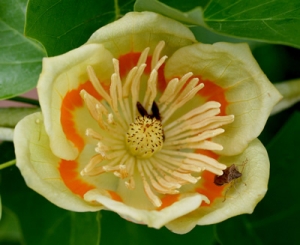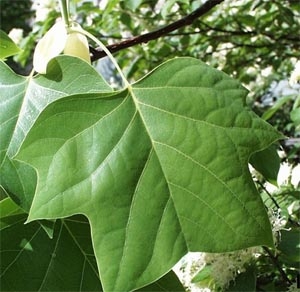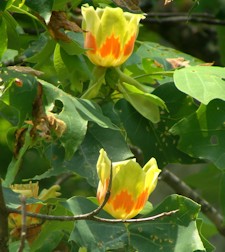Tulip Poplar
By Pat Dickey, Fairfax Master Gardener
 If your answer is tulip poplar, you are correct. This tree, Liriodendron tulipifera, is also known as tulip tree and yellow poplar. Strangely, it is a member of the magnolia family, Magnoliaceae, and is not really a poplar at all. It bears the name tulip poplar because its flowers resemble tulips with greenish-yellow petals and orange corollas. The flowers bloom high in the tree in late spring and early summer. The fruits are 2-inch oblong conelike masses of samaras. The samaras mature in August through October and disperse in late fall and winter. Samaras at the base of the cluster stay in the canopy of the tree, forming the wooden flowers.
If your answer is tulip poplar, you are correct. This tree, Liriodendron tulipifera, is also known as tulip tree and yellow poplar. Strangely, it is a member of the magnolia family, Magnoliaceae, and is not really a poplar at all. It bears the name tulip poplar because its flowers resemble tulips with greenish-yellow petals and orange corollas. The flowers bloom high in the tree in late spring and early summer. The fruits are 2-inch oblong conelike masses of samaras. The samaras mature in August through October and disperse in late fall and winter. Samaras at the base of the cluster stay in the canopy of the tree, forming the wooden flowers.
The leaves of the tulip poplar are four-lobed and notched, resembling the shape of a tulip. In the fall they turn a showy bright gold. The tree’s twigs are reddish-brown, and the large terminal buds have two duckbill-shaped scales. Young tulip poplars have light gray-green, smooth bark; later it develops flat-topped ridges with white furrows in a diamond-shaped pattern.
 Tulip poplars are desirable street trees, shade trees or ornamental trees for large acreage or parks, but they are unsuited for many other urban and residential sites. Young trees have a pyramidal form and are often planted for reforestation purposes because of their attractive shape and rapid growth. They prefer full sun and like rich, well-drained soil, similar to the soil of the forest. The wood from the tulip poplar’s trunk can be used for furniture, veneer, plywood and shingles. The branches of the tree are moderately weak and may become damaged in ice storms and strong winds.
Tulip poplars are desirable street trees, shade trees or ornamental trees for large acreage or parks, but they are unsuited for many other urban and residential sites. Young trees have a pyramidal form and are often planted for reforestation purposes because of their attractive shape and rapid growth. They prefer full sun and like rich, well-drained soil, similar to the soil of the forest. The wood from the tulip poplar’s trunk can be used for furniture, veneer, plywood and shingles. The branches of the tree are moderately weak and may become damaged in ice storms and strong winds.
The tree is of some value to wildlife. Yellow-bellied sapsuckers feed on the phloem tissue, the vascular tissue that conducts sugars and other metabolic products downward from the leaves. Ruby-throated hummingbirds consume nectar from the flowers. The tree’s fruits provide food for gray squirrels in the fall and winter months.
Tulip poplars are usually disease resistant, but they can be susceptible to powdery mildew. See Chapter 4 of the Virginia Tech Pest Management Guide for suitable treatments.
 References
References
• Yellow-poplar Liriodendron tulipifera, Virginia Tech Dendrology
• Tulip poplar, University of Kentucky, Department of Horticulture
• Tulip poplar, University of Maryland Extension
• Tulip poplar, US Department of Agriculture, Natural Resources
Conservation Service